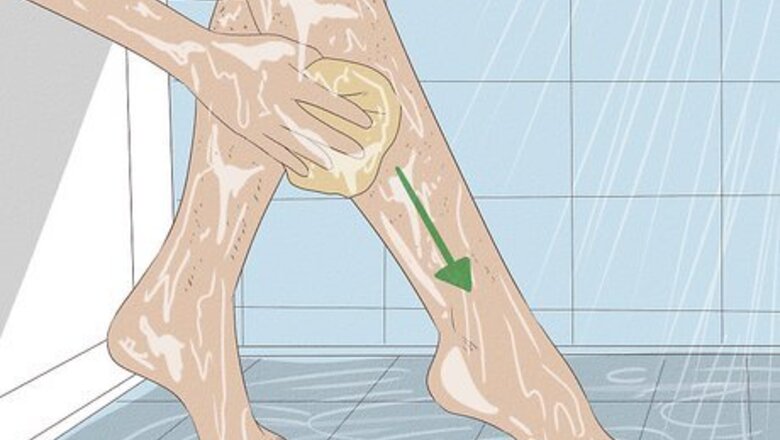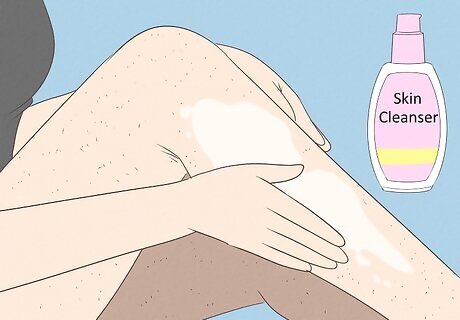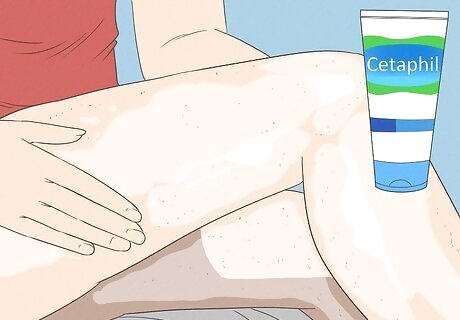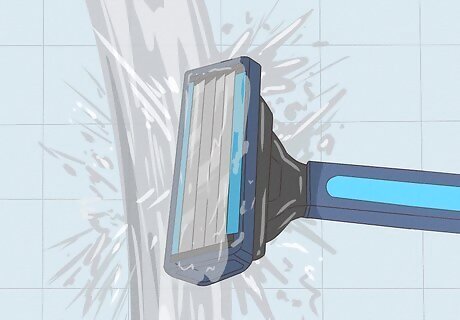
views
Cleansing Your Legs to Reduce Clogged Pores

Shower daily and any time you get sweaty. Regular showers are important for good hygiene and they may also help to prevent strawberry legs. Take a shower once per day to wash away dirt and dead skin cells from your legs. You should also shower after exercising or any time your legs get sweaty. Try taking a shower every morning to help you wake up or shower in the evening to help you relax after a busy day. Use a washcloth to cleanse your legs. Move the washcloth downward or in the direction of your hair growth. Don't scrub against the grain.

Use a mild, fragrance-free skin cleanser. When you wash your legs, make sure that you use a gentle cleanser that does not contain added fragrances, since these may irritate your legs. Instead, look for a cleanser that is labeled as gentle. You can use a gentle cleanser that is meant for your face and body, such as Cetaphil.

Exfoliate your legs 1 or 2 times per week. Exfoliating helps to remove dead skin cells and dirt from your skin that is left over from regular cleansing. Exfoliate your legs once or twice per week to help prevent strawberry legs. Exfoliating may also help you to get rid of existing strawberry legs. Look for an exfoliating product that contains salicylic acid to help fight acne on your legs. Always consult your doctor before using products containing salicylic acid because they might cause certain side-effects

Apply non-comedogenic moisturizers only. Moisturizers that are labeled as non-comedogenic are less likely to clog the pores in your legs and cause pimples. Look for the term non-comedogenic on the bottle of any body lotion you buy. You may also want to avoid moisturizers that contain oil, since some oils may clog your pores. If you cannot find a non-comedogenic body lotion, then look for lotion that is labeled as oil-free.
Shaving Carefully to Prevent Ingrown Hairs

Apply shaving cream to wet legs. Never shave your legs when they are dry. Apply the shaving cream to your legs when they are wet, such as when you are in the shower. Leave the shaving cream on while you are shaving. Do not rinse it off. If shaving irritation is causing your strawberry legs, then you may want to stick with shaving creams that are meant for sensitive skin.

Use a new, sharp razor every time you shave. A dull razor will be less effective at removing your leg hair and it will also increase the chances that you will nick your skin. Instead, always shave your legs with a new, sharp razor. Consider getting a razor meant for sensitive skin to help reduce the chances of irritating your skin.

Shave with the grain of your hair. Most people shave their legs against the grain to get a close shave, but this can increase your chances of ingrown hairs. Shaving with the grain, or in the same direction as your leg hair’s growth, will help to reduce the chances of ingrown hairs as well. Leg hair usually grows down towards your feet, so shave in this direction to shave with the grain. Make sure that you do not press down too hard with the razor or shave too close because this will increase the chances of ingrown hairs.

Rinse the razor between strokes. To ensure that the razor is cutting hairs with each stroke, rinse it under warm running water between strokes. Rinse the blades until all of the shaving cream and hair has been rinsed away. If you have a lot of hair to remove, then you might need to rinse the blade more frequently.

Rinse your legs, pat them dry, and apply lotion. When you have finished shaving your legs, rinse away the remaining shave cream residue. Then, pat your legs dry with a clean towel and apply a layer of lotion to them. Follow the same routine every time you shave to help reduce the chances of ingrown hairs.
Seeking Professional Help for Strawberry Legs

See a dermatologist if acne or ingrown hairs bother you. If you have tried over-the-counter and home treatment strategies and nothing seems to help, then it may be time to see a dermatologist. A dermatologist can offer you stronger and possibly more effective treatment options. They can also help to treat any infections or scarring that strawberry legs might have caused. You may need to ask your primary care physician for a referral.

Ask about retinoid creams to remove dead skin cells. Dead skin cells that build up on your legs may be causing your strawberry legs. If you have tried other products to keep your legs clean and acne-free, then you may want to ask a dermatologist about a prescription retinoid cream. You will need to apply the cream daily and avoid exposing your legs to sunlight while you are using the cream.

Look into laser hair removal. If recurrent ingrown hairs are to blame for your strawberry legs, then you might consider laser hair removal. This will remove the hair on your legs for several months and it should grow back lighter and finer than before. Ask your dermatologist if this might be a good choice for you. You will need between 2 to 6 treatments to remove all of the hair. Keep in mind that laser hair removal is expensive and insurance will not cover the cost. Always consult your doctor before undergoing laser hair removal as it may not be suitable for everyone including pregnant women and people with certain skin types




















Comments
0 comment